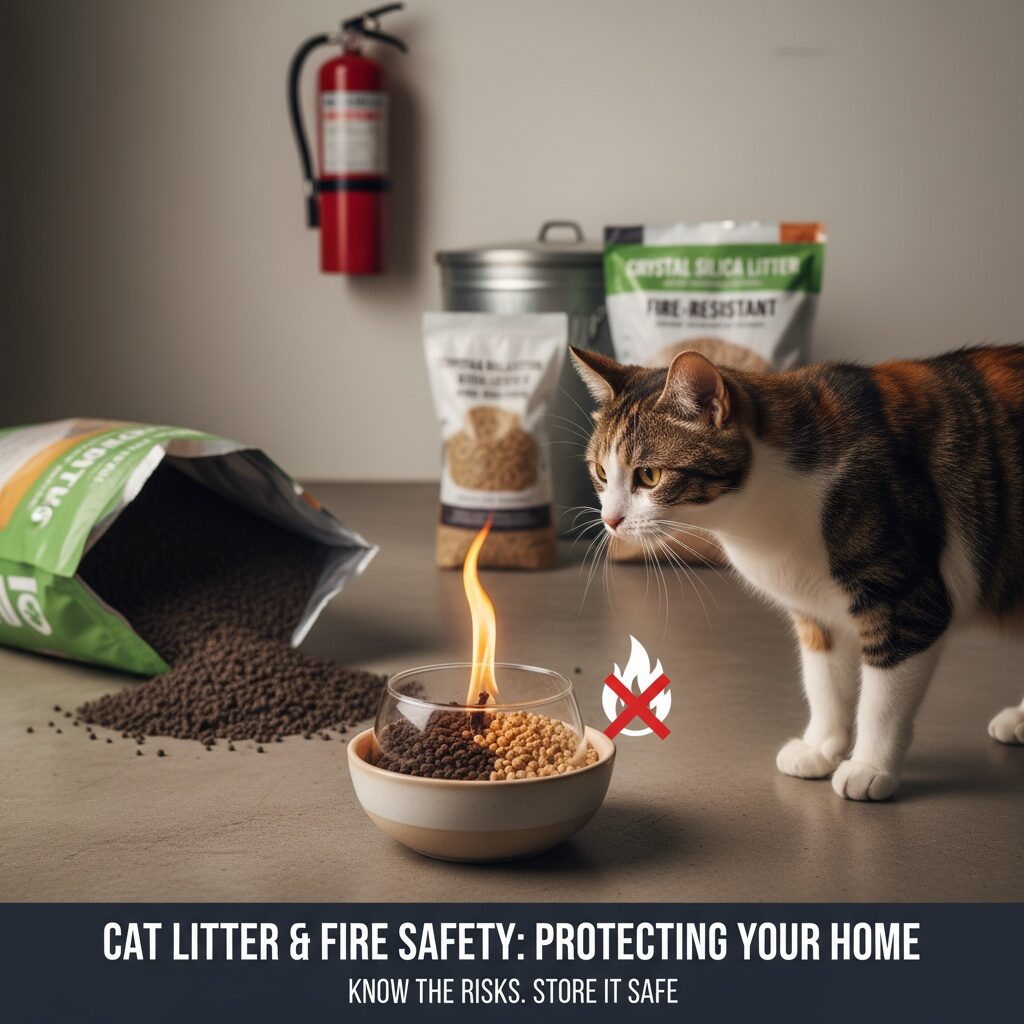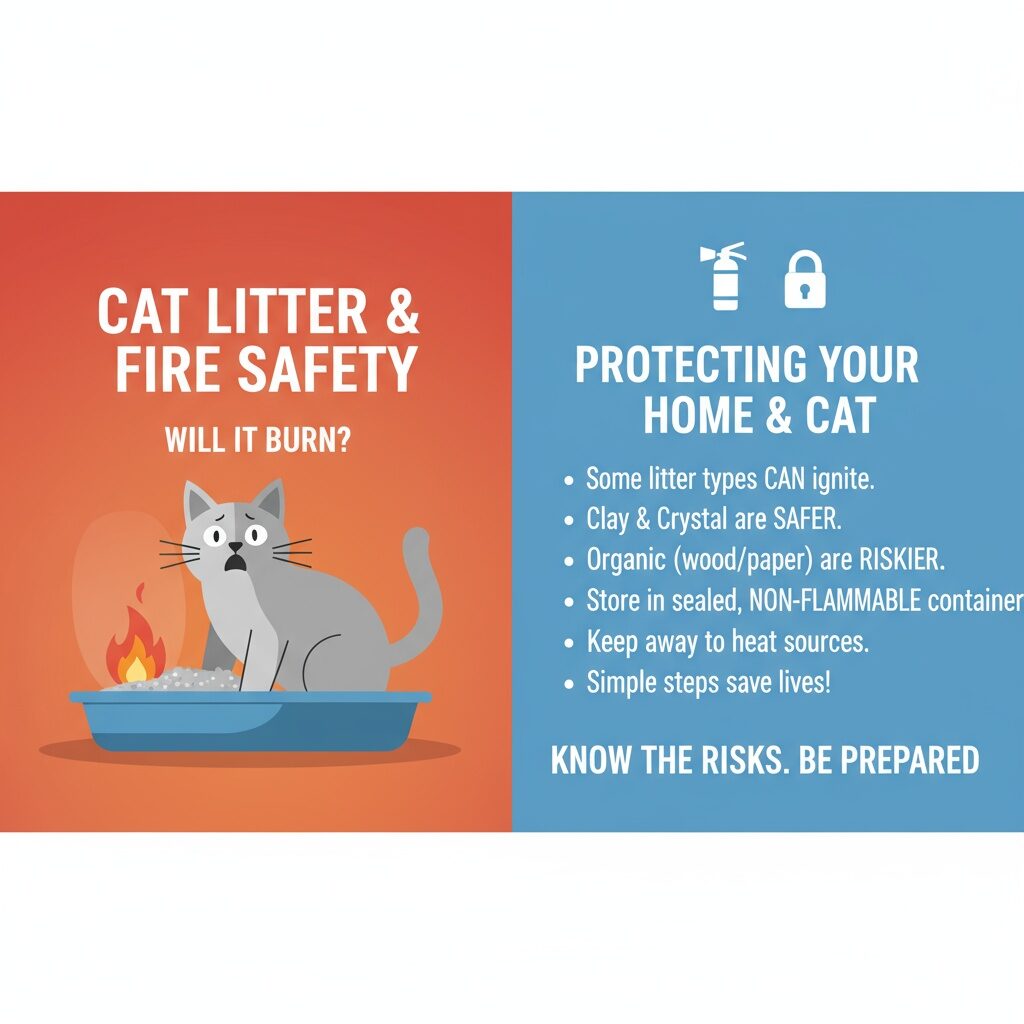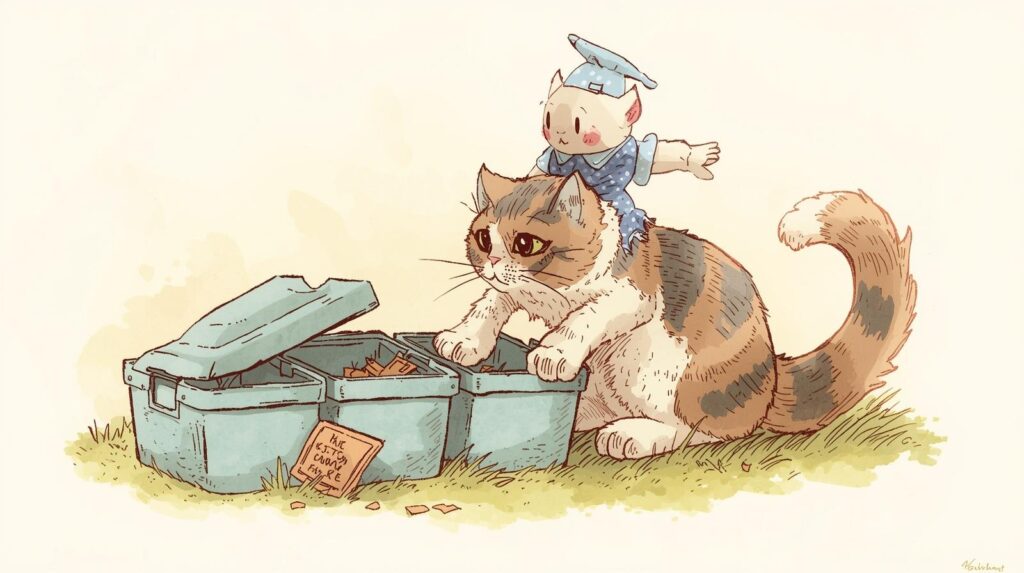
Many cat owners never stop to think about fire safety when it comes to litter, but it is an important question: Will cat litter burn if it gets too hot? The short answer is yes, some types of cat litter can burn, while others are safer and almost fire-resistant.
Understanding which litter can burn, when it becomes a fire risk, and how to store it safely can actually prevent serious accidents at home. This guide explains everything in simple language so you can protect both your cat and your home.
Table of Contents
Is cat litter flammable or not
Not all cat litter is flammable — but some types definitely are. The flammability of the litter depends on the material used to make it.
What makes something flammable?
A material is flammable if:
- It catches fire when exposed to heat, and
- It can continue to burn once the flame starts
This means natural, plant-based litters burn faster than mineral-based ones.
Which types are more likely to burn?
| Litter Type | Fire Risk | Reason |
| Wood Pellet Litter | High | Wood is naturally flammable |
| Corn Litter | High | Completely organic |
| Paper Litter | High | Dry paper burns very quickly |
| Grass Litter | Medium-High | Light fibers catch fire easily |
| Walnut Litter | Medium-High | Shell fibers can smolder |
| Clay Litter | Very Low | Made of earth/mineral |
| Crystal (Silica) | Extremely Low | Does not burn |
So if a cat parent asks, Will cat litter burn inside a room if exposed to heat, the real answer depends on the material.
Does moisture matter?
Yes.
Wet litter (from cat urine) does not burn easily, but fully dry litter can catch fire faster. Heat + dryness = higher risk.
Can Cat Litter Start a House Fire?
Yes — some types of cat litter can start a house fire, but it depends on the material. Plant-based litters (like wood, corn, wheat, grass, or walnut) can burn if exposed to enough heat, sparks, or open flame.
However, clay and silica crystal litter do not burn, so they are not fire starters.
When Does Cat Litter Become a Fire Hazard?
Cat litter can become risky in these situations:
- Near heaters or furnace vents
- Beside a fireplace or wood stove
- Close to a candle or incense stick
- If someone smokes indoors
- Stored in a very hot attic or garage
- If oil-based litter additives are present
Dry, dusty, plant-based litter can ignite quickly, just like sawdust or dry leaves.

Realistic Example
If a smoker accidentally drops a hot ash or cigarette butt into a trash bag filled with used wood or corn litter, it can begin to smoulder and later burst into flame. This is one of the most common causes of fires related to litter.
Which Litters Are the Safest?
| Litter Material | Fire Risk | Safe Indoors? |
|---|---|---|
| Clay | Very Low | Yes |
| Silica Crystal | Very Low | Yes |
| Wood/Pine | High | Use with care |
| Grass | High | Keep away from heaters |
| Corn/Wheat | High | Can smoulder |
| Paper | High | Burns easily |
| Walnut | High | Can hold heat |
Can Cat Litter Spontaneously Combust?
Spontaneous combustion means something catches fire on its own without a spark or open flame.
Most cat litters by themselves do NOT spontaneously combust. However, used litter — especially from plant-based materials — can smolder under the right conditions.
Why Used Litter Is Riskier Than Fresh Litter
When your cat uses the litter box, moisture from urine mixes with the litter. Over time, bacteria break down the urine, creating heat, especially in closed spaces like:
- Sealed trash bags
- Outdoor storage bins
- Hot garages
- Sun-exposed dumpsters
If the litter is organic (wood, corn, wheat, grass, paper), this heat can build up and cause smoldering, which is the first stage before an actual flame.
Conditions That Can Trigger Combustion
Used litter becomes most dangerous when all these combine:
| Condition | What Happens |
|---|---|
| High heat | Speeds bacterial breakdown |
| No airflow | Heat stays trapped |
| Organic material | Acts like fuel |
| Long storage time | Heat keeps building |
Once it becomes hot enough, the material can flare up when oxygen reaches it, such as when a trash bin is opened.
Quick Safety Tip
Never store used, plant-based litter in plastic bags that sit in direct sunlight or inside a hot garage. Always dispose of it quickly or use a metal bin with ventilation.
Which Types of Cat Litter Are Flammable (and Which Are Not)?
Not all cat litter behaves the same around heat or fire. Some types will smolder or burn, while others are naturally non-flammable. To understand real fire safety, you first need to know which materials are risky and which are safe.
Below is the simple breakdown:
Cat Litter Types That CAN Burn
| Litter Type | Why It Is Flammable | Risk Level |
|---|---|---|
| Wood / Pine litter | Made from sawdust and wood fibers (natural fuel) | High |
| Corn litter | Plant-based and can heat up with moisture | Medium–High |
| Wheat litter | Organic, breaks down quickly with heat | Medium |
| Paper pellets (recycled) | Will burn if exposed to flame or extreme heat | Medium |
| Grass seed litter | Plant matter + urine bacteria = heat buildup | Medium–High |
These natural/biodegradable litters are great for the environment — but they can smolder under the right conditions, especially when stored in closed bags or metal-less bins.
Key Safety Insight
Even though clay and crystal litter don’t burn easily, improper disposal of organic litter (corn, wood, paper, grass) is the #1 cause of litter-related hot spots, smoldering, or bin fires.
That’s why people online searching “will cat litter burn” often get mixed answers.
The truth is it depends on the material.
Can Cat Litter Burn in High Heat?
Yes — some types of cat litter can burn in high heat, especially if they are plant-based (wood, corn, wheat, grass, or recycled paper). These materials behave like dried fuel. When exposed to enough heat, they can smolder first and then ignite if oxygen is present.
High heat does not always mean open flame. A fire can start slowly from:
| Source of Heat | Why It’s Risky |
|---|---|
| Heaters or radiators | Constant dry heat → litter dries + overheats |
| Sun-heated garage or car trunk | Stored bags get hot → smoldering risk |
| Near cooking appliances | Oil mist + dry litter = kindling |
| Outdoor fire pits / grills | Wind can blow embers into the litter |
| Closed trash bins | Heat + urine bacteria can create hotspots |
This is why people also search “can I put cat litter near the heater?” and “will cat litter burn in the oven” — they worry about everyday household heat sources.
How High Heat Triggers Burning
- Moisture from urine breaks down litter
- Organic material begins to decompose
- Decomposition creates internal heat
- Heat gets trapped → smoldering starts
- With enough oxygen, an actual flame can appear
This is the same reason why compost piles and hay stacks sometimes start fires — trapped heat + organic material.
Which Litters Are Most Affected by High Heat?
| Litter Type | Heat Risk |
|---|---|
| Wood / Pine litter | Very High |
| Grass seed litter | High |
| Corn & wheat litter | Medium |
| Paper litter | Medium |
| Clay | Very Low |
| Crystal (silica) | Extremely Low |
So when people ask, “Can cat litter burn in the sun?”, the answer is:
Yes — if it is plant-based
No — if it is clay or silica
How to Keep Cat Litter Safe from Heat (Prevention Guide)
Even though not all litter types will ignite, good storage and handling can prevent overheating, smoldering, and fire risk — especially if you use plant-based litter. Below are the real-life safety steps cat owners should follow.
1. Store Litter in a Cool, Dry Place
Avoid keeping it:
- In direct sunlight
- Inside a hot garage
- Next to the stove or dryer
- Near heaters or furnace rooms
Plant-based litter heats up like hay — trapped heat = risk.
2. Use a Proper Storage Container
Choose:
Breathable plastic bins
Containers with ventilation
A shaded and airflow-friendly spot
Avoid:
Metal containers (retain heat)
Fully sealed tubs (trap moisture → smoldering)
3. Never Place the Litter Box Near Heat Sources
This is especially important for small homes or apartments. Avoid placing the litter box:
- beside a radiator
- beside a space heater
- next to a hot oven
- under a sunny window ledge
This directly answers the common search term “can i put cat litter near heater?” — the safe answer is no, especially with wood, grass, or paper-based litter.
4. Dispose of Used Litter Correctly
Urine-soaked or poop-containing litter creates heat + bacteria, which can raise temperature faster than fresh litter.
This is also why people google “can dirty litter start a fire” — yes, if it is stored incorrectly, especially outdoors in summer.
Dispose of dirty litter by:
- Bagging immediately
- Keeping it out of sunlight
- Not piling organic litter for long periods
- Not mixing it with hot ashes or flammable waste
5. Avoid Storing Litter Bags Next to Fire Tools
Keep unused litter far from:
- Fire pits
- BBQ grills
- Firewood stacks
- Smoking zones
Even a tiny stray ember can ignite corn, grass, or pine litter.
Most Fire-Safe Cat Litter Types (Best Choices for Safety)
If you live in a hot climate, keep the litter box in a warm area of your home, or simply want zero fire risk, then switching to a fire-safe litter is the smartest choice. Below are the best categories of litters that do not burn easily and stay stable even in high heat.
1. Clay (Bentonite) Cat Litter — Safest for Heat
Clay litter is made from natural minerals, not organic fibers. That means it does not act as fuel. It may get dusty, but it cannot burn in normal household conditions.
- Best for hot climates
- Safe around heaters
- Very low “smolder” risk
- Good for people worried about “can cat litter catch fire”
2. Silica Crystal Litter — Highly Heat Resistant
Crystal litter (also called silica gel) is one of the most heat-stable options available. It does not ignite, spark, or act like fuel. It can sit in warm rooms without risk.
- Great for apartments
- Lasts longer than clay
- Ideal if you fear “cat litter fire risk”
This is the closest option to true “fireproof cat litter.”
3. Mineral Blends / Mixed Litter
Some modern litters combine clay + mineral materials to improve odor control. These also have very low to zero flammability, making them safe to store anywhere.
What About Plant-Based Litters?
Wood pellets, corn litter, wheat litter, grass seed litter, and recycled paper are eco-friendly, but they can smolder in extreme heat. They are NOT the best choice if fire safety is your top concern.
Safety Ranking (Fast Overview)
| Litter Type | Fire Safety | Heat Rating |
|---|---|---|
| Silica crystals | Excellent | Resistant |
| Wheat/corn | Very Good | Resistant |
| Paper | Medium | Can smolder |
| Wood/pine | Medium | Can smolder |
| Wood / pine | Low | Flammable |
| Grass seed | Clay/mineral | Flammable |
Switching to a fire-safe formula is the easiest upgrade if you’re worried about whether “Will cat litter burn” in your home. It greatly lowers the chance of accidents — especially in summer.
Vet-recommended products
- World’s Best Cat Litter Multiple Cats Unscented Corn
2. Dr Elsey’s Ultra Unscented Clumping Clay Cat Litter
3. Arm & Hammer Unscented Clumping Cat Litter
Further readings
When is it too late to litter train a cat
FAQs About Will Cat Litter Burn?
Will cat litter burn reddit – what do real owners say?
On Reddit, many cat owners say most clay and crystal litter does not burn, but plant-based litter (like wood, corn, or wheat) can smolder if stored in heat. Reddit users also warned that used litter is riskier than fresh because moisture + bacteria can create heat buildup. So yes — people online agree that some litters can burn in high heat, especially when stored incorrectly.
How long will cat litter burn if it catches fire?
Cat litter by itself does not burn like normal wood or coal. If fire does start, it usually smolders slowly, not with big flames. The burning time depends on the material:
Clay litter → stops burning quickly
Paper/corn/grass/wood → burns longer because it is natural fuel
If there is urine in it, smoldering can last longer because heat gets trapped. That is why “can pee litter catch fire” and “can poop litter catch fire” is a real safety question — the answer is yes in rare cases, especially if it’s organic litter.
How to dispose of cat litter in the country (rural areas)?
If you live in a rural area:
Do NOT dump used litter near barns or dry grass (fire risk)
Never burn litter waste
Bury only clay or dirt-based litter — not wood or corn types
Composting is unsafe for pet waste (toxins + parasites)
Instead, use a metal bin with a lid and dump regularly at a safe waste point.
How to dispose of cat litter in an apartment (safe method)
In apartments, follow this method:
Scoop waste daily
Double-bag used litter
Keep it away from balconies with direct sun
Use small trash bags → take out garbage more often
This prevents odor AND also lowers cat litter fire risk caused by trapped heat.
How to dispose of cat litter without plastic bags
You can use:
Paper bags
Compostable litter bags
Flushable litter (ONLY if sewer system allows)
Reusable sealed bins (empty daily)
Just make sure you do not leave organic litter sealed in a hot spot, or it can smolder.
Is it illegal to dump cat litter outdoors?
Yes — in many cities and states, dumping used litter outdoors is illegal because:
It may carry parasites
It attracts wildlife
It can harm soil and water
It can ignite under heat in dry weather
Always dispose of litter through your normal household trash system unless local composting rules specifically allow it.
Cat Litter Disposal Bags — are they safe?
Yes, but choose heavy-duty or compostable bags that do not trap heat. Thin plastic bags can heat up if left in the sun and make smoldering worse — especially with plant-based litter.
Look for:
Compostable bags
Breathable disposal bags
Small-size bags so litter is not stored too long inside
How to dispose of cat poop without a smell
Here are the best tricks:
Scoop daily (don’t let it sit)
Use a sealed pail or bin
Add a baking soda layer to absorb odor
Keep the bin in a shaded/cool area — NOT sunlight
Never store near heaters or hot appliances
This prevents both odor buildup and heat buildup inside the bag or bin.
Wrap Up-Will Cat Litter Burn?
Keeping your cat safe doesn’t stop at choosing the right food, toys, or bedding — even your litter choice matters more than most people realise. While most cat litter isn’t “highly flammable,” some types (like wood pellets, paper litter, and nut-based litter) can burn if exposed to strong heat, open flame, or improper storage. That’s why choosing safer, fire-resistant options like silica gel or clumping clay is a smart move — especially if you live in a hot climate or store litter in small indoor spaces.
Before you leave, here are a few final reminders:
| Safety Tip | Why It Matters |
|---|---|
| Store litter in a cool, dry place | Heat + organic fibers = fire risk |
| Heat + organic fibres = fire risk | One small spark can ignite paper/wood-based litter |
| Use metal or thick plastic containers | Reduces oxygen exposure |
| Choose silica or clay for maximum safety | These materials don’t burn easily |
| Clean humidity often & discard soiled litter | Wet clumping litter can create heat buildup too |
Your cat’s litter area may seem like a tiny corner of your home — but it’s still a place where heat, moisture, and organic materials sit together every day. With just a few smart choices, you can make it both pet-safe AND fire-safe.


